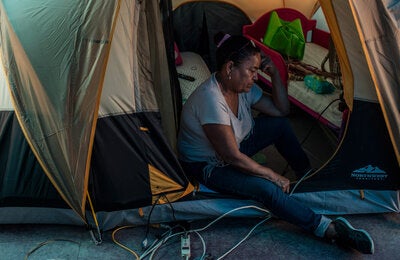

The Director of the Pan American Health Organization (PAHO), Dr. Carissa F. Etienne, today briefed members of the World Health Organization (WHO) Executive Board on the spread of Zika virus in the Americas.
Dr. Carissa Etienne´s Remarks
Zika briefing for Member States
28 January 2016
Executive Board Room
Thank you for the opportunity to address our WHO Member States.
As PAHO Director, and regional director for the WHO office for the Americas, I wholeheartedly welcome the director-general's announcement that she is calling an Emergency Committee meeting on Zika virus and the observed increase in neurological disorders and neonatal malformations, which may be related.
This meeting will mark a vital step in our efforts to halt the spread of Zika, and the conditions that may be associated with this disease, within the Americas region and beyond.
As we look ahead to this meeting, I'd like to take a quick look back beginning last May, when Brazil first reported cases of Zika virus diseases to us under the IHR, the International Health Regulations.
I congratulate Brazil - and all the other 21 countries in the Americas, for their prompt reporting under the IHR. This is key.
PAHO is a region with long experience in tackling mosquito-borne diseases - including dengue and chikungunya.
Since May 2015, we have issued monthly epidemiological alerts advising countries what to do if they have Zika cases, and how to monitor and prepare for its eventual arrival. Through weekly meetings with the national IHR focal points, we have kept all countries informed about the evolving situation. Additionally, we communicated directly with Ministers of Health of the Region providing information on the situation.
We have worked with Member States to mobilize community and social engagement - particularly around vector control; rolling out clean-up campaigns, promoting the use of insecticides and wearing protective clothing.
Brazil first reported an upsurge in microcephaly in October. We promptly convened an expert group that worked round the clock to produce recommendations to help countries improve surveillance and follow-up.
Many unanswered questions remain about the links between Zika virus disease, microcephaly and Guillan Barre syndrome.
So, PAHO has brought together experts from Brazil and the international community, including HQ colleagues to improve our epidemiogical understanding.
We have recognized the important role of the media in keeping the public informed. We have been working for several months with the media in the Americas.
For the past two weeks, since the CDC travel advisory, we've been responding to heightened interest in the US and globally.
Before I end, I must say how grateful I am to partners like US CDC, the Pasteur Institute, Fiocruz and others for so swiftly responding to our call - under the GOARN umbrella.
Throughout the past 8 months we have worked as one WHO and I look forward to continuing this integrated approach to face the Zika challenge.
As the disease spreads across other regions we look forward to deepening collaboration and sharing our experiences.
We must all work together to prevent the further spread of this potentially debilitating disease. Although we are still working to establish causality with Zika, we cannot tolerate the prospect of more babies being born with neurological and other malformations, and more people facing the threat of paralysis due to Guillain-Barre syndrome.
With me today is Dr. Marcos Espinal, our spokesperson for the Zika event and Director of the Department of Communicable Diseases and Health Analysis at PAHO, and Dr. Sylvain Aldighieri, PAHO Incident Manager for Zika.
Dr. Espinal will now make a presentation on key aspects of the Zika outbreak for the Americas.
— https://twitter.com/pahowho #Zika #ZikaVirus



